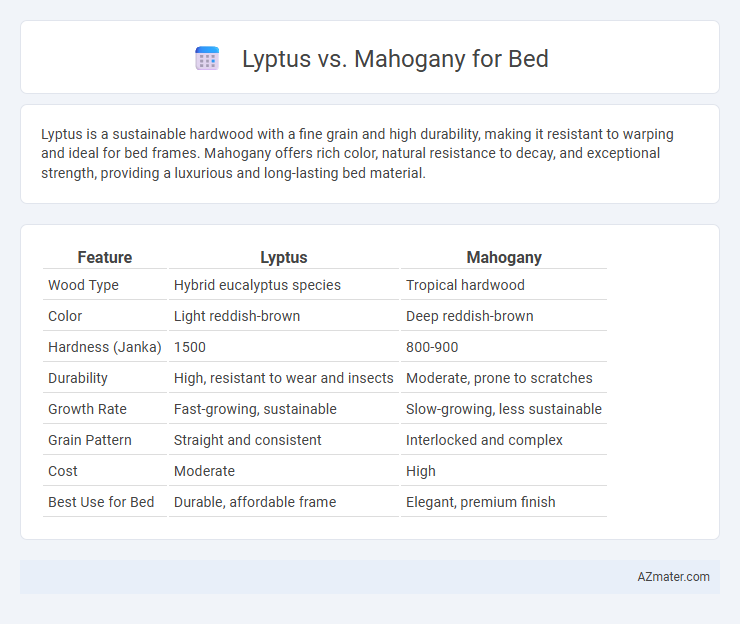Lyptus is a sustainable hardwood with a fine grain and high durability, making it resistant to warping and ideal for bed frames. Mahogany offers rich color, natural resistance to decay, and exceptional strength, providing a luxurious and long-lasting bed material.
Table of Comparison
| Feature | Lyptus | Mahogany |
|---|---|---|
| Wood Type | Hybrid eucalyptus species | Tropical hardwood |
| Color | Light reddish-brown | Deep reddish-brown |
| Hardness (Janka) | 1500 | 800-900 |
| Durability | High, resistant to wear and insects | Moderate, prone to scratches |
| Growth Rate | Fast-growing, sustainable | Slow-growing, less sustainable |
| Grain Pattern | Straight and consistent | Interlocked and complex |
| Cost | Moderate | High |
| Best Use for Bed | Durable, affordable frame | Elegant, premium finish |
Introduction to Lyptus and Mahogany
Lyptus is a sustainable hardwood derived from the Eucalyptus tree, known for its durability, fine grain, and resistance to decay, making it an eco-friendly choice for bed frames and furniture. Mahogany, a tropical hardwood prized for its rich reddish-brown color, smooth texture, and exceptional strength, offers timeless elegance and long-lasting performance in bedroom furniture. Both woods balance aesthetics and functionality, with Lyptus appealing to environmentally conscious consumers and mahogany favored for its classic luxury.
Botanical Origins and Sustainability
Lyptus, derived from Eucalyptus urograndis, is a fast-growing hybrid tree cultivated primarily in Brazil, offering a sustainable alternative due to its rapid harvest cycle and replanting practices. Mahogany, belonging to the genus Swietenia and native to tropical regions of the Americas, grows much slower, leading to concerns about overharvesting and deforestation. The sustainable management of Lyptus plantations contrasts with the restricted availability of mahogany from well-regulated sources, making Lyptus a more eco-friendly choice for bed construction.
Appearance and Color Comparison
Lyptus wood features a light, reddish-brown hue with a fine, consistent grain pattern that gives beds a sleek and modern appearance. Mahogany showcases a deeper, rich reddish-brown tone with natural variations and darker streaks, providing a classic, luxurious look. The color of Lyptus tends to be more uniform and lighter compared to the warm, complex shades found in mahogany, making each ideal for different design aesthetics in bedroom furniture.
Hardness and Durability
Lyptus wood exhibits a Janka hardness rating of approximately 1540, making it notably hard and resistant to dents and wear, suitable for bed construction where durability is essential. Mahogany, depending on the species, typically ranges from 800 to 900 on the Janka scale, indicating a softer texture compared to Lyptus but still offering moderate durability and a smooth finish. When prioritizing hardness and long-term durability for beds, Lyptus provides superior resistance to impact and scratches, while mahogany offers a balance of strength and aesthetic richness.
Workability and Finishing
Lyptus offers excellent workability with a fine, uniform grain that allows for smooth cutting and sanding, making it ideal for detailed bed designs. Mahogany also provides great workability but features a coarser grain that may require more careful handling to avoid tear-out during machining. When it comes to finishing, Lyptus takes stain and finish evenly, producing a consistent appearance, while Mahogany excels with its rich, deep reddish hue that enhances with various stains and polishes, creating a luxurious bed finish.
Cost and Availability
Lyptus wood offers a more cost-effective alternative to mahogany, with prices typically 20-40% lower due to its rapid growth and sustainable harvesting from Eucalyptus plantations. Mahogany, prized for its rich reddish-brown color and durability, commands higher prices and can be harder to source sustainably because of slower growth rates and restricted logging practices. Availability favors Lyptus, which is more abundant in North America markets, while genuine mahogany often requires imports from limited tropical regions, affecting both cost and accessibility for bed manufacturing.
Environmental Impact and Certification
Lyptus, a hybrid eucalyptus species grown in fast-growing plantations, offers a more sustainable choice due to its rapid growth rate and FSC certification that ensures responsible forest management. Mahogany, often harvested from slow-growing tropical hardwood forests, faces higher environmental concerns including deforestation and habitat loss, although some sources carry FSC or PEFC certification to mitigate these impacts. Choosing certified Lyptus reduces carbon footprint and supports renewable forestry, while certified mahogany provides a balance between luxury wood and environmental responsibility when sourced cautiously.
Comfort and Performance in Bed Frames
Lyptus wood offers a dense, durable structure that provides excellent stability and resistance to warping, making it ideal for sturdy bed frames with consistent support. Mahogany, known for its natural strength and smooth grain, delivers a comfortable and solid foundation while adding a luxurious aesthetic to bedroom furniture. Both woods ensure long-lasting performance, but Mahogany's slightly softer texture contributes more to comfort through subtle flexibility in the bed frame.
Maintenance and Longevity
Lyptus offers a durable, low-maintenance option for beds due to its dense hardwood structure that resists scratches and moisture, making it ideal for long-term use. Mahogany, known for its rich color and fine grain, requires regular polishing and protection from humidity to maintain its appearance over time. While both woods provide longevity, Lyptus demands less upkeep, whereas Mahogany offers timeless beauty with moderate maintenance.
Conclusion: Best Wood Choice for Beds
Lyptus wood offers exceptional durability and eco-friendly qualities, making it a smart choice for budget-conscious or sustainable bed frames. Mahogany provides superior aesthetics, rich color, and a timeless appeal, ideal for premium, heirloom-quality beds. For lasting beauty and luxury, mahogany is the best wood choice, while Lyptus excels in cost-effectiveness and environmental sustainability.

Infographic: Lyptus vs Mahogany for Bed
 azmater.com
azmater.com